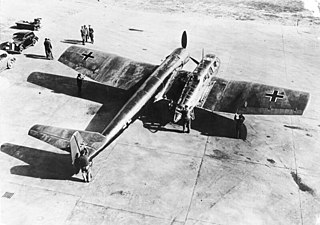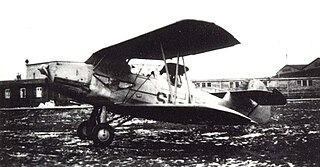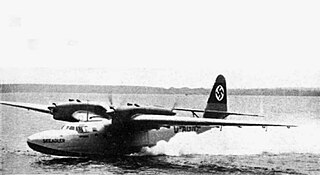Related Research Articles

The Focke-Wulf Fw 44 Stieglitz ("Goldfinch") is a 1930s German two-seat biplane. An early design by Kurt Tank, it was produced by the Focke-Wulf company as a pilot training and sports flying aircraft. It was also built under license in several other countries.

The Arado Ar 68 was a single-seat biplane fighter designed and produced by the German aircraft manufacturer Arado Flugzeugwerke. It was among the first fighters produced when Germany abandoned the restrictions of the Treaty of Versailles and began rearming.

The Arado Ar 240 was a German twin-engine, multi-role heavy fighter aircraft, developed for the Luftwaffe during World War II by Arado Flugzeugwerke. Its first flight was in 1940, but problems with the design hampered development, and it remained only marginally stable throughout the prototype phase. The project was eventually cancelled, with the existing airframes used for a variety of test purposes.

The Blohm & Voss BV 141 was a World War II German tactical reconnaissance aircraft, notable for its uncommon structural asymmetry. Although the Blohm & Voss BV 141 performed well, it was never ordered into full-scale production, for reasons that included the unavailability of the preferred engine and competition from another tactical reconnaissance aircraft, the Focke-Wulf Fw 189.

The Arado Ar 232 Tausendfüßler, sometimes also called Tatzelwurm, was a cargo aircraft, designed and built in small numbers by the German firm Arado Flugzeugwerke during World War II. The design introduced, or brought together, almost all of the features now considered to be standard in modern cargo transport aircraft designs, including a box-like fuselage slung beneath a high wing; a rear loading ramp ; a high-mounted twin tail for easy access to the hold; and various features for operating from rough fields. Although the Luftwaffe was interested in replacing or supplementing its fleet of outdated Junkers Ju 52/3m transports, it had an abundance of types in production at the time, and did not purchase large numbers of the Ar 232.

The Dornier Do 19 was a German four-engine heavy bomber that first flew on 28 October 1936. Only one prototype flew, and it was converted to a transport in 1938. The other two were scrapped.

The Bramo 323 Fafnir is a nine-cylinder radial aircraft engine of the World War II era. Based heavily on Siemens/Bramo's earlier experience producing the Bristol Jupiter under licence, the Bramo 323 saw limited use.

The Arado Ar 66 was a German single-engined, two-seat training biplane, developed in 1933. It was also used for night ground-attack missions on the Eastern Front. It was engineer Walter Rethel's last design in collaboration with Arado, before Walter Blume, assigned as Arado Flugzeugwerke's chief design engineer in 1933, took over the bulk of the Arado firm's design duties.

The Arado Ar 197 was a German World War II-era biplane, designed for naval operations for the never-completed German aircraft carrier Graf Zeppelin. Only a few prototypes were built; the project was abandoned in favour of the Messerschmitt Bf 109T and Me 155.

The Heinkel He 72 Kadett ("Cadet") was a German single-engine biplane trainer of the 1930s.

The Arado Ar 76 was a German aircraft of the 1930s, designed as a light fighter with a secondary role as an advanced trainer in mind.

The Arado S I was a biplane trainer built in Germany in 1925. The first of three prototypes was powered by a Bristol Lucifer radial engine, while the other two Arado S.Ia aircraft were fitted with the Siemens-Halske Sh 12. The Siemens-Halske Sh 11 powered the Arado S III, a virtually identical aircraft of which only a single prototype was constructed and sold to Turkey.

The Dornier Do 26 was an all-metal gull-winged flying boat produced before and during World War II by Dornier Flugzeugwerke of Germany. It was operated by a crew of four and was intended, in civilian service, to carry a payload of 500 kg (1,100 lb) or four passengers on the Lisbon to New York route. In military service it carried as many as eighteen passengers.

The Flettner Fl 265 was an experimental helicopter designed by Anton Flettner.

The Focke-Wulf Fw 62 was a reconnaissance floatplane, designed and built by Focke-Wulf for use by Nazi Germany's Kriegsmarine. Only four were built.

The Ago Ao 192 Kurier was a small German twin-engined aircraft designed and built by AGO Flugzeugwerke in the 1930s. A small production run of six aircraft followed three prototypes, these being used as transports.

The Arado Ar 198 was a prototype reconnaissance aircraft, developed by Arado Flugzeugwerke, with backing from the Luftwaffe, who initially preferred it over the Blohm & Voss BV 141 and the Focke-Wulf Fw 189. However, when flight tests were carried out the aircraft performed poorly and did not impress the Luftwaffe. One aircraft was completed in 1938.

The Arado Ar 77 was a German twin-engined monoplane, designed as an advanced training aircraft from 1934.

The Hamburger Flugzeugbau Ha 135 was the first aircraft produced by the new aircraft subsidiary of the German company Blohm & Voss.
The Gotha Go 241 was a low-wing twin-engined four-seat transport aircraft manufactured by Gothaer Waggonfabrik in the early 1940s and intended for the general aviation market.
References
- ↑ "Arado Ar 69". Wehrmacht-History. Archived from the original on 3 March 2016. Retrieved 25 September 2017.
- ↑ Green, William (2010). Aircraft of the Third Reich (1st ed.). London: Aerospace Publishing Limited. p. 34. ISBN 978-1-900732-06-2.
- ↑ Schneider, Helmut (1941). Flugzeug-Typenbuch 1941 (PDF) (in German) (1941 ed.). Leipzig: Herm. Beyer Verlag. p. 14. Archived from the original (PDF) on 2018-09-08. Retrieved 2018-12-20.